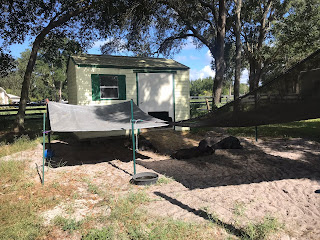Spider and Snake Bites in Pigs - information on spider bites, snake bites, and how to respond in both cases. The importance of seeking immediate veterinary care for both types of bites.
Spider Bites: Most spider bites are minor, but some, such as the black widow, brown widow, and brown recluse spiders, can be dangerous. Symptoms of a bite from one of these might include initial swelling and redness, followed by intense pain, abdominal pain, and sweating.
Brown recluse spiders are commonly found indoors in dark areas like closets, cellars, and under furniture. Black widow and brown widow spiders can be found hiding under things such as tables, chairs, the base of potted plants and under the lip of kiddie pools.
 |
| Brown Widow Spider under lip of a kiddie pool. |
Treatment involves cleaning the wound, applying a cool compress, over-the-counter pain relievers, and prompt medical attention if symptoms worsen or the bite's source is unknown.
 | ||
| Swollen hand from Brown Widow Spider bite. |
To my knowledge none of my pigs have ever been bitten by a spider. However, one got me a couple of years ago when I grabbed the kiddie pool to flip it over for cleaning. It was extremely painful.
Snake Bites: It's a dangerous misconception that pigs are immune to snake bites. While they may have some natural defenses, they are not immune. While pigs possess a thicker layer of skin and a substantial layer of adipose tissue (fat) which can slow the absorption of venom into the bloodstream. This provides a degree of resistance, not immunity. This adipose tissue acts as a buffer, making it harder for the venom to reach blood vessels quickly.
Venom still reaches the bloodstream, and bites in areas with less fat are more dangerous. Pigs' natural inclination to kill snakes highlights the importance of treating every snake as potentially venomous. Prevention involves recognizing local snake species, and assuming any bite is venomous. Key actions include restricting the pig's movement, immobilizing the bite area, keeping the pig calm, and immediately seeking veterinary attention.
Treatment Recommendations: Do not attempt to capture or kill the snake. Avoid cutting the bite wound, applying ice packs/tourniquets, or administering any medication without veterinary guidance. Prompt veterinary care is critical. Antivenom is a primary treatment (if available), though it can be expensive and has potential allergic reactions. The goal with snake bites is to slow venom spread.
Identification: It can be a challenge to distinguish between venomous and harmless snakes, thus treat all snakes as potentially dangerous. You can use a few identification tips, including checking eye shape, head shape, presence of heat-sensing pits, and rattles. But, if you are like me, I don't want to get that close. Understanding bite marks, noting close puncture marks from fangs, and ragged bite marks from non-venomous snakes, can also help determine if a snake was poisonous.
The snakes pictured below are both from my yard. I had never heard of the Coach Whip and with some research after taking this picture was able to find that it is not interested in attacking one of my pigs. It is hunting small rodents like mice, rats and squirrels. The Coral Snake is the second one that I have seen in my yard in a couple of months. A neighbor killed the first one. This one slithered away.
 |
| Coach Whip Snake |
 |
| Coral Snake |
Key Takeaways: Both spider and snake
bites can pose serious risks to pigs. Prompt veterinary intervention,
proper first aid, and a cautious approach to both animals are crucial.
Understanding local snakes and treating every snake as a potential threat are vital for pig safety.














